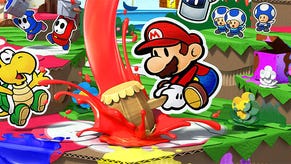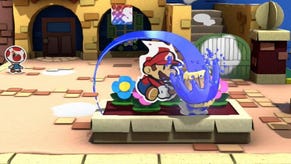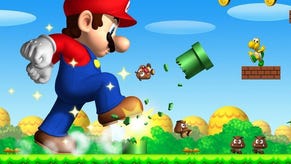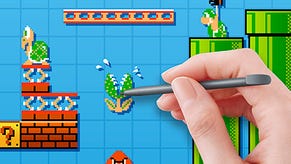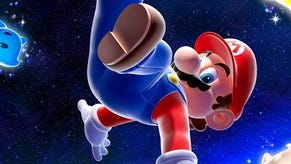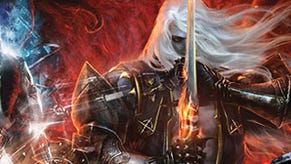The Tactile, Tangible Evolution of Yoshi's Wooly World
Producer Takashi Tezuka explains that the unique visual style of Yoshi's upcoming Wii U adventure isn't just about looks; it's also shaped the way the game plays.
This article first appeared on USgamer, a partner publication of VG247. Some content, such as this article, has been migrated to VG247 for posterity after USgamer's closure - but it has not been edited or further vetted by the VG247 team.
I can always tell when developers have grown weary of fielding the same question from the press over and over again. The instant the question drops, the interview subject's body language immediately changes to become more distant as they recite the script for an answer that's become rote through repetition.
Sometimes, they've even heard the question so often they preemptively assume any somewhat similar question is leading toward the same tired inquiry and attempt to head it off before the pass. Such was the case when I interviewed Nintendo's Takashi Tezuka at E3 about Yoshi's Wooly World and led off by asking his take on how Mario Maker and Wooly World represent different takes on the evolution of Mario through the years. His response?
"I would hate for you to take this the wrong way," he said, "but it hasn't really evolved in a massive way. What a Yoshi game is... you have Yoshi, and he throws eggs. And I don't want to change that core element."

Typical of Nintendo's media-trained key development staff, Tezuka did his best to remain cordial as he responded, passing his comments off lightly as a joke. But I could tell just from the change in his body language that he gets a lot of people asking about why all the Yoshi games are basically the same — a refrain he no doubt heard plenty of in the wake of this spring's Yoshi's New Island. A game that, many people noted, wasn't new in the least.
But that wasn't what I had asked. On the contrary, I was curious to hear more about how Yoshi's Wooly World differs from standard Yoshi platformers. For starters, even though it hews more closely to the Yoshi's Island style than to, say, the more unconventional Yoshi's Story, players aren't toting around a baby Mario this time. That's a first for the more linear Yoshi action games, which generally use Kamek the Koopa's desire to abduct baby Mario as a combination plot device and game mechanic that replaces a tradition health bar. Rather than work against a countdown timer for a kidnapped infant here, you instead have a more standard health meter. So why not include a little Mario knit out of yarn this time, I asked?
"You think we should have one?" Tezuka laughed. "I wanted to create a world that was about Yoshi, so I didn't even consider putting Mario it.
"While I was working on New Mario, I had the chance to play Kirby's Epic Yarn," he recalled. "I'm always thinking of ideas for a new Yoshi game, but at the time I was working on Mario. But I was so impressed by the aesthetics of Kirby's Epic Yarn that I thought it would be a good idea to asked Good Feel to create a Yoshi game with me. I approached them and suggested they work with me to make an action game using yarn and craft materials in their stunning visual style, with all-new game mechanics."
The craft-inspired visuals — easily the most gorgeous example of "real world" materials I've ever seen represented in a game — comprise one half of the two major changes Wooly World brings to the Yoshi series. The look of the game has evolved considerably since its reveal at last year's E3; Good Feel took the simpler, outline-driven look of Kirby's Epic Yarn and fleshed out the character models considerably. Rather than consisting of simple two-dimensional yarn shapes, Yoshi and his foes now have depth and volume, appearing more as fully knit figurines that stretch and deform and even burst into component threads when devoured by the second player.

Therein lies the other major difference between Wooly World and previous Yoshi adventures: It's fully a two-player cooperative experience. Perhaps that shouldn't come as a surprise given the feature's inclusion in Epic Yarn, but it had more precedent in Kirby's titles (e.g., Kirby and the Amazing Mirror). The multiplayer in Wooly World draws heavily on the mechanics seen in the New Super Mario Bros. titles — as you'd expect, given Tezuka's involvement with both — all the way down to Yoshi's ability to slurp up the other player's character and spit it out again.
Of course, this being a Yoshi game rather than Mario, egg-creating and egg-tossing factor into the mechanics as well. This means you can in fact transform another player's Yoshi into an egg and chuck it at foes, leaving the other player stuck and unable to do much of anything until you lob them at a target. The potential for trolling and abuse is, obviously, quite high.
The co-op design provides more than just opportunities for emotional torment, though. Yoshi's abilities and physics remain the same as in Yoshi's Island, including the standard flutter jump, which can be boosted (or spoiled) by another player. By throwing another Yoshi as if it were an egg, you can collaboratively reach otherwise inaccessible areas as well.
"When I made the original Yoshi's Island, we used a distinctive hand-drawn visual style," says Tezuka. "At the time, I wanted to make something that looked really high-quality. At that time, our visual style was beautiful within the hardware limitations. This time around, now that we're in HD, we're able to get into more detail and texture, which allows us to incorporate game mechanics that make use of the material."
Still, I feel the truly notable changes to Wooly World's mechanics to come from the new look of the game. As in Epic Yarn, Good Feel has applied a sort of real-world logic to the hand-crafted construction of the game. Given that everything is made of yarn and felt, they ask, how does that impact the way game elements interact with one another?
The answered they've settled on has been to make nearly everything deformable or interactive, slightly changing the way the rules of Yoshi's Island work. Instead of throwing eggs at winged clouds to make invisible platforms appear, you simply throw an egg (or rather, a ball of yarn) at the outline of the platform itself; the yarn of the egg wraps itself around the sketched-in framework, creating the platform upon contact. Likewise, when you toss an egg at an enemy too large or prickly for Yoshi to swallow — say, a Piranha Plant — the target doesn't simply pop out of existence. Instead, the yarn wraps itself around the enemy, binding it to render it helpless but not taking it entirely out of play. As such, you can now interact with certain enemies in new ways — using a bound Piranha Plant as a platform to gain some extra height, for instance. These changes will likely be modest, but they promise to introduce new and surprising elements to the game, something most Mario fans found sorely lacking in Yoshi's New Island.
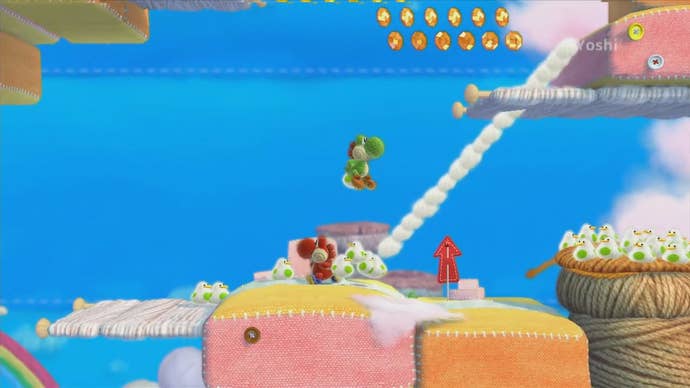
According to Tezuka, these tweaked elements were a natural result of the game's look and feel. "I was actually considering the mechanical changes as part of the yarn aesthetic — the aesthetic actually ties into the functionality of the game," he says. "It's only possible because of the yarn. With our previous graphical styles, that just wouldn't have made sense. But now that we're using these new materials and textures, it's just part of how the game plays."
But these changes will only likely register with veteran players, and Tezuka admits they're not necessarily the group he has in mind as he designs Yoshi titles.
"That's what's behind creating Yoshi games for me — to make what's right for the hardware, and for the time. Of course, obviously, we want to make our games fun to play. If the game is made with care and is high-quality, it's something you'll want to keep and play for a long time. So I want to make something today that young people who play the game today will want to keep and hold on to so that when they're older they'll have fond memories attached to it."
At the very least, that could explain why he seems so tired of answering questions about the series' innovation.


